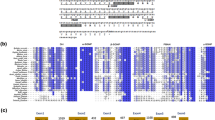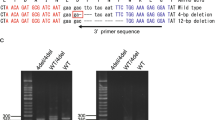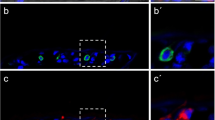Abstract
Pheromone perception is thought to be mediated by pheromone-binding proteins (PBPs) in the lymph surrounding the olfactory receptors. We cloned and characterized two PBP genes (SlitPBP1 and SlitPBP2) from the common cutworm, Spodoptera litura (F.; Lepidoptera: Noctuidae), which encode PBPs belonging to two different PBP groups. Western blot analysis of the crude antennal extracts with SexigPBP1 antibody revealed a single immunoreactive band (much stronger in male than in female) of ∼16 kDa, in agreement with the calculated values for SlitPBPs. From genomic DNA, two introns and a similar exon/intron structural pattern were identified in each PBP genes, but the introns differed in length within and between PBP genes. The expression patterns of two SlitPBP genes, with respect to tissue distribution and sex, were further investigated by reverse transcriptase-polymerase chain reaction (RT-PCR) and real-time PCR. Although the two PBP genes were expressed only in the antennae of both sexes, reflecting the antennal specificity of PBPs, the transcription levels of PBP genes differed between the sexes and the genes. The transcription levels of SlitPBP1 and SlitPBP2 in females were only 2.1% and 7.0%, respectively, relative to those in males, and the levels of PBP2 compared with PBP1 were 31.4% and 95.3% in males and females, respectively. These differential expression levels might suggest different roles played by the two SlitPBPs in the perception of sex pheromone both in males and females.






Similar content being viewed by others
References
Abraham, D., Löfstedt, C., and Picimbon, J. F. 2005. Molecular characterization and evolution of pheromone binding protein genes in Agrotis moths. Insect Biochem. Mol. Biol. 35:1100–1111.
Altschul, S. F., Gish, W., Miller, W., Myers, E. W., and Lipman, D. J. 1990. Basic local alignment search tool. J. Mol. Biol. 215:403–410.
Bendtsen, J. D., Nielsen, H., VonHeijne, G., and Brunak, S. 2004. Improved prediction of signal peptides: SignalP 3.0. J. Mol. Biol. 340:783–795.
Bette, S., Breer, H., and Krieger, J. 2002. Probing a pheromone binding protein of the silkmoth Antheraea polyphemus by endogenous tryptophan fluorescence. Insect Biochem. Mol. Biol. 32:241–246.
Bohbot, J., and Vogt, R. G. 2005. Antennal expressed genes of the yellow fever mosquito (Aedes aegypti L.); characterization of odorant-binding protein 10 and takeout. Insect Biochem. Mol. Biol. 35:961–979.
Bradford, M. A. 1976. A rapid and sensitive method for the quantification of microgram quantities of protein utilizing the principle of protein-dye binding. Anal. Biochem. 72:248–254.
Callahan, F. E., Vogt, R. G., Tucker, M. L., Dickens, J. C., and Mattoo, A. K. 2000. High level expression of “male specific” pheromone binding proteins (PBPs) in the antennae of female noctuid moths. Insect Biochem. Mol. Biol. 30:507–514.
de Santis, F., François, M. C., Merlin, C., Pelletier, J., Maïbèche-Coisné, M., Conti, E., and Jacquin-Joly, E. 2006. Molecular cloning and in situ expression patterns of two new pheromone-binding proteins from the corn stemborer, Sesamia nonagrioides. J. Chem. Ecol. 32:1703–1717.
Dong, S. L., and Du, J. W. 2002. Chemical identification and field tests of sex pheromone of beet armyworm Spodoptera exigua. Acta Phytophylacica Sin. 29:19–24.
Du, G., and Prestwich, G. D. 1995. Protein structure encodes the ligand binding specificity in pheromone binding proteins. Biochemistry 34:8726–8732.
Erwin, T. L. 1982. Tropical forests: their richness in Coleoptera and other arthropod species. Coleop. Bull. 36:74–75.
Fan, W. M., Sheng, C. F., and Su, J. W. 2003. Electrophysiological and behavioral responses of both sexes of the cotton bollworm, Helicoverpa armigera Hübner to sex pheromones. Acta Entomologica Sinica 46:138–143.
Forstner, M., Gohl, T., Breer, H., and Krieger, J. 2006. Candidate pheromone binding proteins of the silkmoth Bombyx mori. Invert. Neurosci. 8:177–187.
Hansson, B. S. 1995. Olfaction in Lepidoptera. Experientia 51:1003–1027.
Huang, C. X., Zhu, L. M., Ni, J. P., and Chao, X. Y. 2002. A method of rearing the beet armyworm Spodoptera exigua. Entomological Knowledge 39:229–231.
Klusák, V., Havlas, Z., ulisek, L., Vondrásek, J., and Svatos, A. 2003. Sexual attraction in the silkworm moth: Nature of binding of bombykol in pheromone binding protein-an ab initio study. Chem. Biol. 10:331–340.
Krieger, J., Ganssle, H., Raming, K., and Breer, H. 1993. Odorant binding proteins of Heliothis virescens. Insect Biochem. Mol. Biol. 23:449–456.
Krieger, J., VonNickisch-osenegk, E., Mameli, M., Pelosi, P., and Breer, H. 1996. Binding proteins from the antennae of Bombyx mori. Insect Biochem. Mol. Biol. 26:297–307.
Krieger, J., Grosse-Wilde, E., Gohl, T., and Breer, H. 2005. Candidate pheromone receptors of the silkmoth Bombyx mori. Eur. J. Neurosci. 21:2167–2176.
Kristensen, N. P. 1991 Phylogeny of extant hexapodspp.125–140, in CSIRO (ed.). The Insects of Australia: A Textbook for Students and Research Workers. Melbourne University Press, Melbourne, Australia.
Kumar S., Tamura K., and Nei M. 2004. MEGA3: Integrated software for molecular evolutionary genetics analysis and sequence alignment. Brief. Bioinform. 5:150–163.
Kyte, J., and Doolittle, R. F. 1982. A simple method for displaying the hydropathic character of a protein. J. Mol. Biol. 157:105–132.
Laemmli, U. K. 1970. Cleavage of structural proteins during the assembly of the head of bacteriophage T4. Nature 227:680–685.
LaForest, S. M., Prestwich, G. D., and Löfstedt, C. 1999. Intraspecific nucleotide variation at the pheromone binding protein locus in the turnip moth, Agrotis segetum. Insect Mol. Biol. 8:481–490.
Laue, M., and Steinbrecht, R. A. 1997. Topochemistry of moth olfactory sensillae. Int. J. Insect Morphol. Embryol. 26:217–228.
Lautenschlager, C., Leal, W. S., and Clardy, J. 2007. Bombyx mori pheromone-binding protein binding nonpheromone ligands: Implications for pheromone recognition. Structure 15:1148–1154.
Livak, K. J., and Schmittgen, T. D. 2001. Analysis of relative gene expression data using real-time quantitative PCR and the \(2^{ - \Delta \Delta C_{\text{T}} } \) method. Methods 25:402–408.
Ljungberg, H., Anderson, P., and Hansson, B. S. 1993. Physiology and morphology of pheromone specific sensilla on the antennae of male and female Spodoptera littoralis (Lepidoptera: Noctuidae). J. Insect Physiol. 39:253–260.
Maїbèche-Coisné, M., Jacquin-Joly, E., Francois, M. C., and Nagnan-LeMeillourm, P. 1998. Molecular cloning of two pheromone binding proteins in the cabbage armyworm Mamestra brassicae. Insect Biochem. Mol. Biol. 28:815–818.
Maida, R., Krieger, J., Gebauer, T., Lange, U., and Ziegelberger, G. 2000. Three pheromone binding proteins in olfactory sensilla of the two silkmoth species Antheraea polyphemus and Antheraea pernyi. Eur. J. Biochem. 267:2899–2908.
Maida, R., Ziegelberger, G., and Kaissling, K. E. 2003. Ligand binding to six recombinant pheromone binding proteins of Antheraea polyphemus and Antheraea pernyi. J. Comp. Physiol. B 173:565–573.
Maida, R., Mameli, M., Müller, B., Krieger, J., and Steinbrecht, R. A. 2005. The expression pattern of four odorant-binding proteins in male and female silk moths, Bombyx mori. J. Neurocytology 34:149–163.
Mitchell, E. R., and Tumlinson J. H. 1994. Response of Spodoptera exigua and S. eridania (Lepidoptera: Noctuidae) males to synthetic pheromone and S. exigua females. Florida Entomol. 77:237–247.
Mittapalli, O., Wise, I. L., and Shukle, R. H. 2006. Characterization of a serine carboxypeptidase in the salivary glands and fat body of the orange wheat blossom midge, Sitodiplosis mosellana (Diptera: Cecidomyiidae). Insect Biochem. Mol. Biol. 36:154–160.
Nagnan-Le Meillour, P., Huet, J. C., Maïbeche, M., Pernollet, J. C., and Descoins, C. 1996. Purification and characterization of multiple forms of Odorant/Pheromone binding proteins in the antennae of Mamestra brassicae (Noctuidae). Insect Biochem. Mol. Biol. 26:59–67.
Nakagawa, T., Sakurai, T., Nishioka, T., and Touhara, K. 2005. Insect sex-pheromone signals mediated by specific combinations of olfactory receptors. Science 307:1638–1642.
Nemoto, H., Takahashi, K., and Kubota, A. 1980. Reduction of the population density of Spodoptera litura (F.) (Lepidoptera: Noctuidae) using a synthetic sex pheromone. I. Experiment in taro field. Jap. J. Appl. Entomol. Zool. 24:211–216.
Ochieng, S. A., Anderson, P., and Hansson, B. S. 1995. Antennal lobe projection patterns of olfactory receptor neurons involved in sex pheromone detection in Spodoptera littoralis (Lepidoptera: Noctuidae). Tissue Cell 27:221–232.
Pashley, D. P., and Ke, L. D. 1992. Sequence evolution in mitochondrial ribosomal and ND-1 genes in Lepidoptera: implications for phylogenetic analyses. Mol. Biol. Evol. 9:1061–1075.
Pelosi, P., Zhou, J. J., Ban, L. P., and Calvello, M. 2006. Soluble proteins in insect chemical communication. Cell. Mol. Life Sci. 63:1658–1676.
Picimbon, J. -F., and Gadenne, C. 2002. Evolution of noctuid pheromone binding proteins: identification of PBP in the black cutworm moth, Agrotis ipsilon. Insect Biochem. Mol. Biol. 32:839–846.
Plettner, E., Lazar, J., Prestwich, E. G., and Prestwich, G. D. 2000. Discrimination of pheromone enantiomers by two pheromone binding proteins from the gypsy moth Lymantria dispar. Biochemistry 39:8953–8962.
Prestwich, G. D. 1996. Proteins that smell: Pheromone recognition and signal transduction. Bioorgan. Med. Chem. 4:505–513.
Obertson, H. M., Martos, R., Sears, C. R., Todres, E. Z., Walden, K. K. O., and Nardi, J. B. 1999. Diversity of odorant binding proteins revealed by an expressed sequence tag project on male Manduca sexta moth antennae. Insect Mol. Biol. 8:501–518.
Schneider, D., Schulz, S., Priesner, E., Ziesmann, J., and Francke, W. 1998. Autodetection and chemistry of female and male pheromone in both sexes of the tiger moth Panaxia quadripunctaria. J. Comp. Physiol. A 182:153–161.
Srinivas, K., and Rao, P. A. 1999. Management of Spodoptera litura (F.) infesting groundnut by mating disruption technique with synthetic sex pheromone. J. Entomol. Res. 23:115–119.
Steinbrecht, R. A., Laue, M., and Ziegelberger, G. 1995. Immunolocalization of pheromone-binding protein and general odorant binding protein in olfactory sensilla of the silk moths Antheraea and Bombyx. Cell Tissue Res. 282:203–217.
Sun, F., Du, J. W., and Chen, T. H. 2003. The behavioral responses of Spodoptera litura (F.) males to the female sex pheromone in wind tunnel and field trapping tests. Acta Entomologica Sinica 46:126–130.
Sun, F., Hu, Y. Y., and Du, J. W. 2002. The sex pheromone communication system of Spodoptera litura (Fabricius). Acta Entomological Sinica 45:404–407.
Tamaki, Y., Noguchi, H., and Yushima, T. 1973. Sex pheromone of Spodoptera litura (F.) (Lepidoptera: Noctuidae): isolation, identification and synthesis. Appl. Ent. Zool. 8:200–203.
Tamaki, Y., Osawa, T., Yushima, T., and Noguchi H. 1976. Sex pheromone and related compounds secreted by the virgin female of Spodoptera litura (F.). Jap. J. Appl. Ent. Zool. 20:81–86.
Thompson, J. D., Gibson, T. J., Plewniak, F., Jeanmougin, F., and Higgin, D. G. 1997. The Clustal X windows interface: flexible strategies for multiple sequence alignment aided by quality analysis tools. Nucl. Acid Res. 25:4876–4882.
Vogt, R. G., and Riddiford, L. M. 1981. Pheromone binding and inactivation by moth antennae. Nature 293:161–163.
Vogt, R. G., Rogers, M. E., Franco, M. D., and Sun, M. 2002. A comparative study of odorant binding protein genes: differential expression of the PBP1-GOBP2 gene cluster in Manduca sexta (Lepidoptera) and the organization of OBP genes in Drosophila melanogaster (Diptera). J. Exp. Biol. 205:719–744.
Wakamura, S., and Takai, M. 1995. Communication disruption for control of the beet armyworm, Spodoptera exigua (Hübner), with synthetic sex pheromone. Jap. Agric. Res. 29:125–130.
Wakamura, S., Takai, M., Kozai, S., Inoue, H., Yamashita, I., Kawahara, S., and Kawamura, M. 1989. Control of the beet armyworm Spodoptera exigua (Hübner) (Lepidoptera: Noctuidae) using synthetic sex pheromone. I. Effect of communication disruption in Welsh onion fields. Appl. Entomol. Zool. 24:387–397.
Xiu, W. M., and Dong, S. L. 2007. Molecular characterization of two pheromone binding proteins and quantitative analysis of their expression in the beet armyworm, Spodoptera exigua Hübner. J. Chem. Ecol. 33:947–961.
Acknowledgments
We are grateful to Dr Jing-Jiang Zhou (Rothamsted Research, UK) and Professor Paolo Pelosi (University of Pisa, Italy) for valuable advice and comments on the manuscript. This work was supported by funds from the National Natural Science Foundation of China (grant number 30571220), Jiangsu Province Natural Science Foundation (grant number BK2004098), and Basic Research Special Foundation of the central-level scientific institute for public welfare (Agro-Environmental Protection Institute of MOA) (grant number 2007-xwm-08).
Author information
Authors and Affiliations
Corresponding author
Rights and permissions
About this article
Cite this article
Xiu, WM., Zhou, YZ. & Dong, SL. Molecular Characterization and Expression Pattern of Two Pheromone-Binding Proteins from Spodoptera litura (Fabricius). J Chem Ecol 34, 487–498 (2008). https://doi.org/10.1007/s10886-008-9452-0
Received:
Revised:
Accepted:
Published:
Issue Date:
DOI: https://doi.org/10.1007/s10886-008-9452-0




